
LONDON COUNTRY AF and AN classes.This page created 18th March 2001AN: Leyland Atlanteans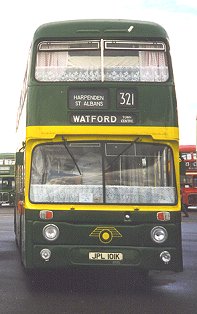 Whereas London Transport settled on Daimler Fleetlines after the XA-XF trials,
London Country plumped for the Leyland Atlantean.
The bodywork provider of choice was Park Royal,
who had produced a smart modern-looking design with a window spacing
that took account of stairs and dual doorways.
It was a design taken on board by other bodybuilders,
so that the small AF class of Daimler Fleetlines shared the layout,
as did the non-standard batch of Metro-Cammell-Weymann ANs.
Whereas London Transport settled on Daimler Fleetlines after the XA-XF trials,
London Country plumped for the Leyland Atlantean.
The bodywork provider of choice was Park Royal,
who had produced a smart modern-looking design with a window spacing
that took account of stairs and dual doorways.
It was a design taken on board by other bodybuilders,
so that the small AF class of Daimler Fleetlines shared the layout,
as did the non-standard batch of Metro-Cammell-Weymann ANs.
London Country did not have the resources to just buy all the double-deckers it needed to replace the RTs and Routemasters (RMCs, RMLs and RCLs). But by choosing right with their first buy they had a standard bus that was available to buy for quite a few years, while they built up the fleet, until by the final days of London Country it was the sole double-decker design in use.
But by then the standardisation had worn a little thin,
with the purchase of secondhand buses from other companies
in order to have cheap capacity to fight tender battles.
Most had the common Park-Royal style bodies,
but the ex-Scottish examples had panoramic - windowed bodies by Alexander,
and the ex-Manchester buses had GM-style twin blind boxes.
Preserved AN1 at North Weald in June 1998So within the class there were a number of variants, as the years rolled past:
Park Royal AN1-90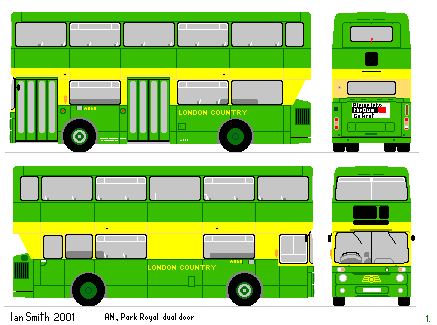 The first batch were delivered during 1972, between March and October.
They were nicely proportioned standard dual-doorway buses
with forward-of-centre staircases
and a standard Atlantean bustle. Layout was H43/29D,
and they were finished in the mid-green and bright yellow
introduced with the AFs.
The first batch were delivered during 1972, between March and October.
They were nicely proportioned standard dual-doorway buses
with forward-of-centre staircases
and a standard Atlantean bustle. Layout was H43/29D,
and they were finished in the mid-green and bright yellow
introduced with the AFs.
The first sixteen went to Hertford to convert the 310/A (Hertford-Enfield)
(plus 331/A journeys) at the end of April 1972,
but did not prove as reliable as the RTs that they displaced.
Metro-Cammell-Weymann AN91-120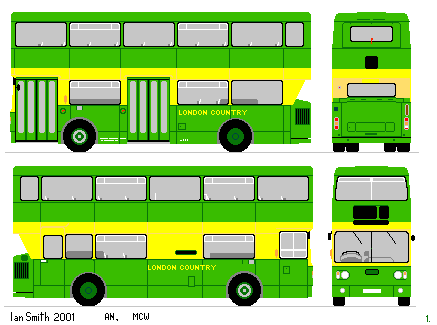 In October 1972 London Country received a bonus when an order for thirty
Atlanteans ordered by Midland Red was found to be more than required there,
and the buses were diverted by NBC to hard-pressed London Country.
In October 1972 London Country received a bonus when an order for thirty
Atlanteans ordered by Midland Red was found to be more than required there,
and the buses were diverted by NBC to hard-pressed London Country.
They had bodies by Metro-Cammell-Weymann,
to basically the same design as the Park Royals,
but with detail differences. Most obvious was the lower front treatment,
with a plainer dash with a central vent. The roof was also fitted over the ends,
rather than between them.
Most of them went to Luton, Garston, Stevenage and Hertford to run alongside the Park Royals:
availability figures were not as high as with the replaced RTs!
It cannot be said that the Atlanteans settled to straightforward steady use. As was found elswhere, they did suffer from inadequate ventilation in the engine compartment, coupled to a tendency to pop the thrust bearings when the engine overheated and expanded. RTs continued to appear as spares, and some of the routes officially reverted to RT operation for various periods, including the trunk 321 and 310.
After the arrival of the MCWs the position remained fairly static,
with ANs at Garston, Luton, Stevenage, Harlow, Leatherhead, Guildford and East Grinstead,
the AFs at Godstone and Routemasters elswhere,
with the surviving RTs plugging the gaps and making up for deficiencies all round.
The priority for renewals shifted to the single-deck fleet.
Park Royal AN121-123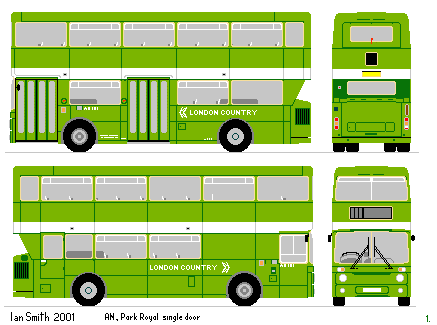 In April 1974 London Country acquired another three Park Royals,
as replacements for the three XAs sold to Hong Kong.
These three were to the new AN68 mechanical specification.
Their bodywork was also different,
seating only 71 (H43/28D) with a forward staircase and three-track number blinds at the front.
They wore the mandatory NBC green and white livery,
and were distinguished by cream window rubbers instead of black.
In April 1974 London Country acquired another three Park Royals,
as replacements for the three XAs sold to Hong Kong.
These three were to the new AN68 mechanical specification.
Their bodywork was also different,
seating only 71 (H43/28D) with a forward staircase and three-track number blinds at the front.
They wore the mandatory NBC green and white livery,
and were distinguished by cream window rubbers instead of black.
As they were slightly odd they were sent to fill the place of the three XAs at East Grinstead. Park Royal AN124-183, Roe AN184 -293It was some time before London Country felt the need to buy more new Atlanteans. The Routemaster buses (RMLs, RMCs and RCLs) were performing fairly reliably - as far as Leyland's appalling spares policy allowed - throughout most of the seventies, and other needs were met using the Leyland National, and a batch of Bristol VRs (the BT class) for Grays in 1977.
After that it was Crawley's turn.
With Gatwick Airport on its doorstep Crawley New Town was a real growth area.
Local bus needs had mostly been met using Merlins and Swifts (including the dual-door SMWs),
with larger buses on the trunk 405 and 434.
Atlanteans arrived during the spring of 1978
and were used for a complete relaunch of the town's local services in July,
when they sported C-Line branding and adverts on their NBC livery.
The old local routes were swept away and replaced by routes C1 to C8,
designed to give greater reliability of service
and to provide the journeys actually required by the users! Novel!
With the successful changes in place Crawley
continued to be one of the few areas of London Country that actually made a profit.
By March the Routemasters had all gone, with the survivors and casualties all bought by London Transport for further service, resurrection or cannibalisation. For April 1980 Amersham received ten Atlanteans for the Chilternlink reorganisation, replacing single-deckers. More Roe-bodied Atlanteans arrived in 1980 and 1981, making up for the deficiencies in the system and replacing inadequate or non-standard buses. The Bristol VRs at Grays were sold to Bristol Omnibus Co after just three years service. The Hertfordshire new towns were beneficiaries too. But changes were on the way, and this glut of new buses was to be followed by a drought as the new economic wonders of the eighties began to unfold. Nationalised Bus Company, as a public sector industry, was to feel the squeeze. The government of the day was preparing to run down the sector ready for a cheap sell-off into private hands, before instituting the new tendering rules that would prohibit cross-subsidy of routes, and thereby pour public money into private pockets. The day of the second-hand buses was at hand... Part 2: Tenders, secondhand buses, and privatisation
|
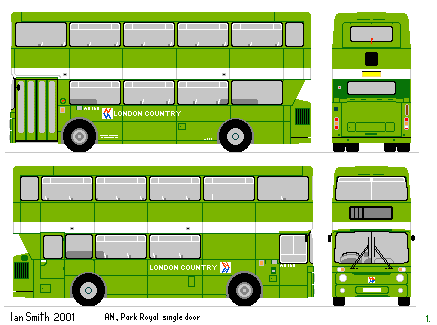 But by 1978 London Country felt the need to dispose of the remainder of its crewed buses,
and ordered more AN68 Atlanteans with Park Royal bodywork.
But Park Royal could only manage the first sixty, so the remainder were bodied to the same design by Roe.
These were just like the "East Grinstead" three,
except for single doors and black window rubbers! Layout was H43/30F.
Livery was NBC green with a white band and coloured NBC logo.
They looked very smart when new.
But by 1978 London Country felt the need to dispose of the remainder of its crewed buses,
and ordered more AN68 Atlanteans with Park Royal bodywork.
But Park Royal could only manage the first sixty, so the remainder were bodied to the same design by Roe.
These were just like the "East Grinstead" three,
except for single doors and black window rubbers! Layout was H43/30F.
Livery was NBC green with a white band and coloured NBC logo.
They looked very smart when new.
 Bus Stop
Bus Stop AF
AF part1
part1 part2
part2